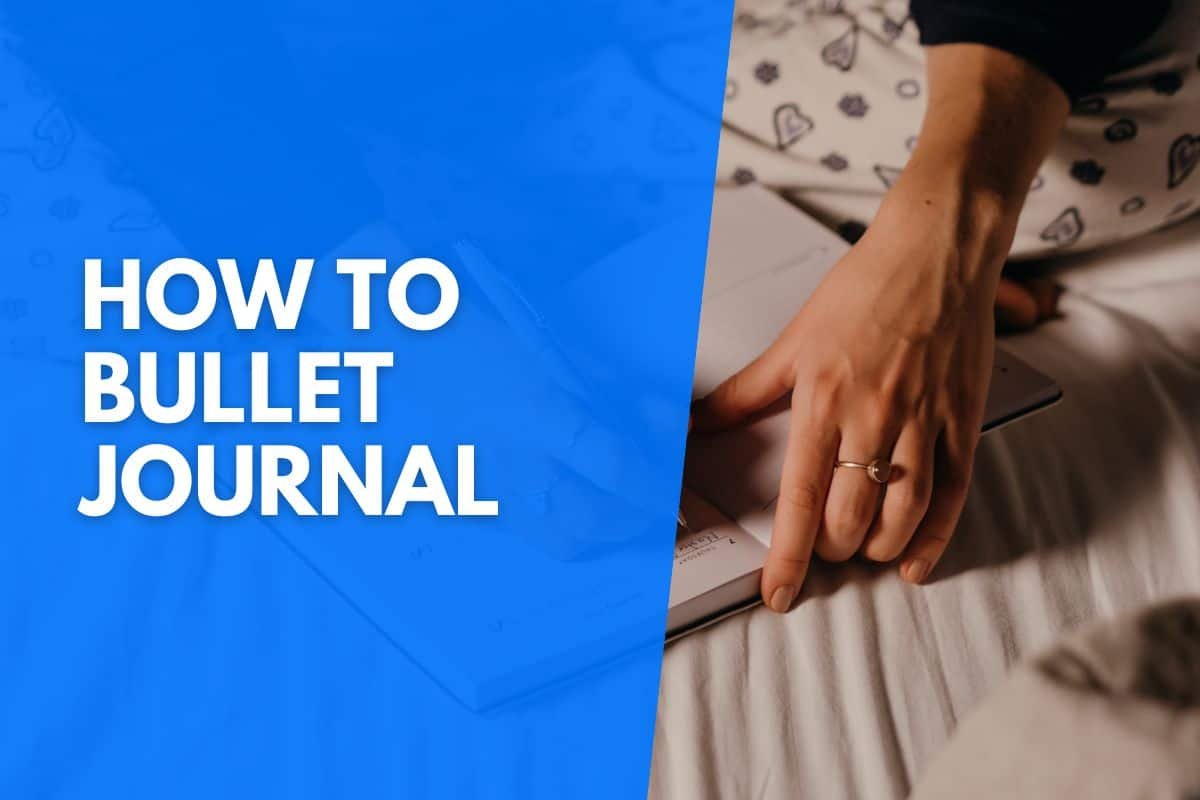If you’re a fan of personal diaries, you’ll be an even bigger fan of bullet journaling. Instead of a traditional diary, bullet journals are completely personalized to you and contain multiple sections.
They can take notes, track mental and physical health, and record long-term and short-term goals.
In this article, we will cover how to bullet journal, everything from A to Z.
How to bullet journal like a pro:

1. Know Its Purpose
One of the greatest benefits of a bullet journal is that you can choose what you need or want it to be to your advantage. If you’re thinking about learning how to bullet journal, your first step should include figuring out its purpose.
Ask yourself what things you need help with, what you need to record or remember, and what the end goal of your bullet journal needs to be.
A bullet journal doesn’t have to serve a single purpose, as it could be a place to track your monthly, weekly, daily, or long-term goals. Figuring out what you want your journal to be will help you with its framework and the content you decide to put inside it.
2. Get A Journal
When you use the same bullet journal for the entire year or the remainder of the year, you will need to invest in a good quality journal.
Your bullet journal experience could be negatively impacted if you choose one of poor quality or one that won’t suit your needs. When you need to choose the ideal journal for you, take some time to consider the quality of the papers it holds.
Smooth and thick pages are essential, especially if you use highlighters or pens that could bleed through the pages. This could result in some pages tearing or the back of some pages being unusable.
Another factor to consider is if you want plain pages, dot grids, or lined pages. Generally, having a dotted grid bullet journal is preferred, as it could help you to write straight and neatly.
Others may become distracted by a dotted grid, which comes down to what you find easiest to write on without getting distracted.
If you plan on using your bullet journal to store important documents or loose pieces of paper, you can choose one with a back pocket, as it will lower the risk of losing these pages.
Another factor to consider is whether or not to purchase a bullet journal with a bookmark. Remember that most high-quality bullet journals will contain a bookmark, which will help you remain organized and flip to the page where you left off!
3. Get Supplies
All you need to start your bullet journaling venture is a bullet journal and a quality journaling pen! The stationery you need will significantly depend on how creative you want to get in your bullet journal. A good place to start stationery-wise would be to invest in a few gel pens.
Gel pens are most useful in bullet journals as they are versatile and glide smoothly on paper. If you prefer different colored gel pens, you can buy them in packs and use them to decorate or separate different pages as you go.
You don’t need a lot to get started on your bullet journal, and if you need a few things along the way, you can get what you need until you feel like your stationery collection is ideal for all your bullet journaling needs!
4. Make A Key Page
A key will be one of the most simple pages of your bullet journal. It would be best to place your key page on one of the first pages of your bullet journal, as it will help you keep track of the symbols you like to use throughout your bullet journal and what they mean to you.
For instance, if you use a heart symbol for your most important tasks, you can draw the same symbol on your key page, labeling it as “important.”
Keep in mind that a key page can consist of words, colors, letters, or even stickers. Everyone’s key pages will look different as our brains work differently.
You need to find symbols that will help you to remain organized and allow you to prioritize your tasks and goals as needed.
5. Create An Index
When you think about creating your Index, you can refer to any book you may have. An index page will typically be on one of the first pages of your journal, and it is crucial to remain organized and refer back to the most important things in your bullet journal.
Your Index page doesn’t have to be complicated or extravagant. The simpler, the better! It could just be a normal index page you would find on the first page of a book- a list of page descriptions and their corresponding page numbers, making finding things easier.
You will fill your Index over time, but for this step, writing a title on the first page and labeling it as “Index” will be ideal. If you’re afraid you may run out of space on your index page, you can leave an additional page blank in case!
6. Number Pages
Before starting with the official first page in your bullet journal, it would help to number your pages! Page numbers are a crucial part of any bullet journal; you will need to write them on your index page as you fill it slowly but surely.
Using the same number format throughout your journal is recommended, as keeping them in the same place on each page will allow you to find them immediately.
You can write your page numbers at the top of every page or at the bottom. It’s crucial to find a place to quickly locate the page’s number and add it to your Index.
This will make your work much easier and faster when you need to look for something specific that you may have written on a page!
7. Have A Future Log
A future log will be ideal if you forget about fun or important events you will need to attend over the year. A future log is also known as a yearly log.
It can contain anything that will happen in the upcoming months, such as meetings, project deadlines, or even more casual occurrences, such as your family or friends’ birthdays.
If you’re planning a trip over the coming months, a future log can help you to get ahead of it, such as helping you take a leave of absence from work or when to start packing!
For convenience, it would help if your future log is located as close as possible to the front of your bullet journal, ideally, just after your key and index page.
You can choose one or two pages for your future log and update it during the year as new things pop up or when you see fit.

8. Have A Daily Log
Daily logs in your bullet journal are essential, as this will be where you spend most of your time.
A daily log can consist of anything you need, but a good start, especially if you’re a beginner to bullet journaling, would be with the date, important meetings or appointments, and your “To-do list” for the specific day.
After you have stated these crucial things, you can leave a space empty for any additional bullet journal ideas that may pop up or things you need to get done. This empty space is also ideal for any ideas or things that have happened that you want to document in your bullet journal.
Most people would cross off their daily “To-do lists” in their bullet journal’s daily logs, which will help you to remember what you need to get done while giving you a sense of accomplishment while completing them.
9. Have A Weekly Log
A weekly log is a perfect place to keep consistent track of everything you need to remember in the coming week, and by knowing what you need to accomplish in a week, you can break down these tasks for yourself in every daily log as well!
If you’re in the last week of the current month, you may want to include important things you cannot afford to forget about. This may include things such as paying your cable bill, paying your rent, and any other essential weekly payments!
Note that you can have a weekly log at the start and end of every new week. This would help you to keep track of the things you may have forgotten.
In this case, you can move the uncompleted tasks to your weekly log for the following week.
10. Have A Monthly Log
Many become confused with a future log and a monthly log in a bullet journal, and getting it right in the first few months could be challenging. However, where your future log would consist of a much broader perspective, a monthly log will help you to narrow it down.
For instance, you can create a new monthly log at the start or end of every month to help you to keep track of what you achieved during that month. Don’t spend too much time at the start of a new month’s log, as you can always go back and add things you have missed.
You could also refer to your future log for every new monthly log, as you may need to repeat things relevant to the new month’s log!
11. Move Tasks
Moving tasks accurately and accordingly is crucial in any bullet journal. Things happen, so you may need to move your daily or weekly tasks by a few days.
Set up your new daily and weekly log, preferably using the same format as before. This will help to keep things looking neat and organized. If you have some tasks you still need to complete, you can transfer these tasks to your next log.
You could also create different themes for different months if you do not prefer using the same format month after month. Many encourage switching up formats, as it will help to keep you engaged and interested in your bullet journal.
However, remember that you don’t need to move all your uncompleted or remaining tasks to the following month. If one or two tasks are no longer worth completing or worrying about, you may cross them out.
Crossing out unnecessary and uncompleted tasks will help cut unnecessary information, shifting your focus to more important tasks. This could also help you achieve a sense of accomplishment, as you will realize which tasks require your attention and which do not.
12. Update Index
Updating your bullet journal’s Index will only work if it’s constantly updated and done correctly! Of course, you won’t be able to do your Index without starting to write in your bullet journal, so you will need to update it as you go!
Keep in mind that your Index doesn’t need to include any of your daily logs, but you can add your weekly and monthly logs to it for easy referencing.
An index should always be done chronologically, with its corresponding page numbers, and most of all, it should be as specific as possible.
If you happen to run out of room on your Index, you could split the page in half or flip to the next available page, the one you left open for if you may need it!

13. Store ideas
Storing your daily, weekly, or monthly ideas at the back of your bullet journal is ideal. Ideas are collections, which are different from your logs, as it’s more of a broad to-do list that you want to accomplish during the year. Your ideas page will include anything that doesn’t count as a log.
This could include a book you want to read, making plans with certain friends, restaurants you want to visit, the music you want to listen to, or shows you want to watch. It’s always good to fill in your ideas page as they come to you, allowing you to refer back to them when you need inspiration or something to do.
This is also ideal for hobbies you want to try, and if you’re ever stuck and don’t know what activity you want to do next, you can plan by choosing something from your bullet journal.
Many people also add a “bucket list” to their ideas page, as it helps them to remember the large and exciting milestones they want to achieve, bringing them one step closer to achieving them!
If you’re a perfectionist, you can even add your ideas section to your Index, making for a more organized and perfect look!
14. Have A Collections Page
A collections page is a little different from an idea page, which could consist of several pages, depending on what collections you want.
Some people use bullet journaling primarily for mental health or physical health. For these purposes, a mood, sleep, or habit tracker would be ideal to know what you want to do differently. These collections could also include a health or general diet and weight loss tracker.
For others, a bullet journal focuses more on goals, which is where a savings and income tracker would be especially handy!
If you prefer your bullet journal to focus more on daily things, you can add a collection page of your grocery lists, cleaning schedules, and any other day-to-day activities you may find applicable.
15. Schedule Journaling
When you are new to bullet journaling, it could be easy to become lost in it during the first few days or weeks, especially if you have personalized it and want to continue doing it. Bullet journaling could be time-consuming, and many spend days or weeks decorating, personalizing, and writing in theirs.
When you notice you are not getting your daily or weekly tasks done due to constantly decorating or writing in your bullet journal, you risk the journal losing its primary purpose, which is to track the most important things in your life.
Therefore, making a bullet journal schedule is advised daily, allowing you to allocate a certain amount of time and effort to your bullet journal without exceeding the desired timeframe.
Recommended times for bullet journaling would be when your day ends or you have a gap between important things, such as breakfast, lunch, or dinner. Bullet journaling can take up as much or as little time as you want to devote to it.
You can spend hours on it daily or a few minutes completing all your pages. It is advised to spend fifteen minutes to half an hour a day on your bullet journal to build a healthy and constant relationship with it. The choice is yours.




